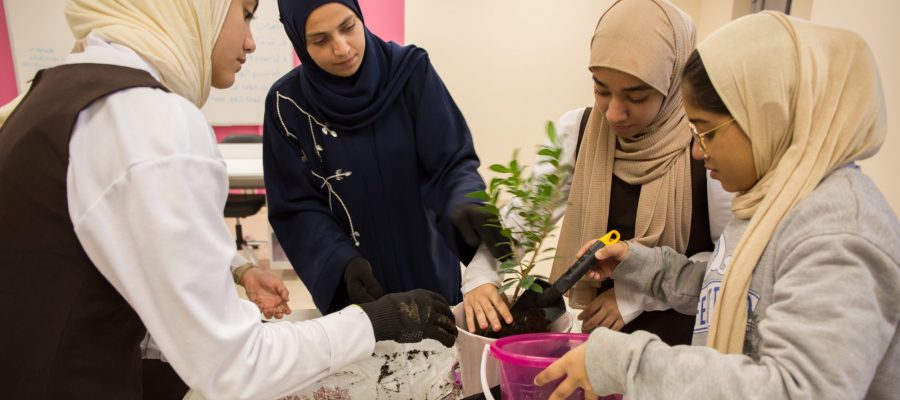Interactive classroom activities provide an opportunity for students to express opinions, offer suggestions, and ask questions, all while practicing English and becoming more confident in their speaking.
Most programs use textbooks in their classrooms. A textbook can be a springboard for easy-to-develop communicative activities. This is especially true for units that are developed around a theme and that include interesting photos and artwork. The following suggestions offer four ideas for easy-to-plan interactions based on textbook content. These ideas should be tweaked to relate to your program and students’ interests and needs.
1. True or False
Textbook material: An interesting photo from a unit.
Handout: A list of eight sentences about the photo. Give the list to Student A.
Directions: Work in pairs. Student A will read each sentence to Student B. Listen carefully! Only four of the sentences are true. Write only the true sentences you hear.
Comment: You will be surprised how many times Student A will need to repeat each sentence! Student A can assist Student B with grammar and spelling as needed.
Example:

Student A:
- It rained very hard.
- It’s still raining now.
- This man evacuated from his home.
- The water in his house is deep.
- His house is going to have a lot of damage.
- The man is calling for help.
- He’s hoping that someone will help him.
- He’s getting into a rescue boat.
2. Take Out Your Phones!
Textbook material: A unit based on the states, countries health, or other informational text.
Handout: A list of facts about the topic that students need to “find” on their phones or computers.
Directions: Work in pairs or groups of three. Find this information on your phone or computer.
Comment: Some students use their phones to text, message, take photos and play games. This activity helps students use a browser more effectively. It is best to give just one sheet to the group so that students work together instead of competing to “find” the information first!
Example: Find this information about our state.
| 1. Borders | |
| 2. Capital | |
| 3. Governor | |
| 4. Population | |
| 5. Three largest cities | |
| 6. Date it became a state | |
| 7. Three major industries | |
| Etc. |
3. My Partner and I
Textbook material: Almost any unit!
Handout: The same list of seven to ten questions for each student.
Directions: Ask your partner each question and record his/her answer. Then, write sentences comparing yourselves.
Comment: This works well when talking about routines, work, and school.
Example: My schedule
Ask your partner each question. Write his or her answers. Then, write a sentence about yourselves.
| Question | My Partner |
| 1. Do you work full time or part time? | e.g. Full time |
| 2. Do you wear a uniform? | e.g. Yes |
| 3. How do you get to work? | |
| 4. What time do you start work? | |
| Etc. |
Sentences:
1. We both work full time.
- Aya wears a uniform, but I don’t.
4. Dialogue Preparation
Textbook material: Any unit.
Handout: Two lists of four or five questions. Each list will have different questions, which will be the basis for a dialogue.
Directions: First, Student A will dictate his/her list to Student B. Then, Student B will dictate his/her list to Student A. Students will then use the questions to prepare and act out a dialogue.
Comment: In a dialogue, the questions are usually the most difficult part for students. This pre-dialogue activity gets the students talking and gives them the basis for a realistic conversation.
Example: Calling 911 (local emergency number) for a medical emergency
Student A: Student B:
What’s the emergency? Is the person breathing?
Is anyone hurt? How old is the person?
Where are you? Is your door unlocked?
Is this person conscious? What medications does this person take?
What is the role of the teacher as students work in pairs and in groups? Circulate around the room as your students work on a task, stopping by each group. Be sure that students are comfortable with the activity directions. Answer questions. If a student is having difficulty with a sentence, repeat it slowly and ask the student to repeat after you. As you listen to students, you may wish to jot down words, phrases, or sentences that you can focus on later. Listening to students speaking may give you a clearer idea of their ability to express themselves.
Be sure to let us know how these activities go in your class in the comment section below!
Barbara Foley is the co-author of English in Action. To learn more about English in Action, third edition, visit ELTNGL.com/EIA3
Author: Barbara Foley
Barbara Foley had planned on taking early retirement after 38 years as a full-time professor of ESOL at Union County College, Elizabeth, New Jersey, USA. However, her “retirement” lasted only five months and she is now back in the classroom, directing an ESOL program for refugees. She has presented at numerous workshops, conferences, and colleges throughout the United States and Mexico, specifically in the areas of listening, CALL, grammar, communicative classroom activities, Generation 1.5 students, and Extensive Reading. Her many publications include English in Action, Grammar in Action, Listen to Me, Now Hear This, and workbooks for the Heinle Picture Dictionary.



Just Thank you,from Albania,I’m a German Teacher,my dream is Amerika,and I read in English.Thank’s Nadjola Ciko,Macaj.